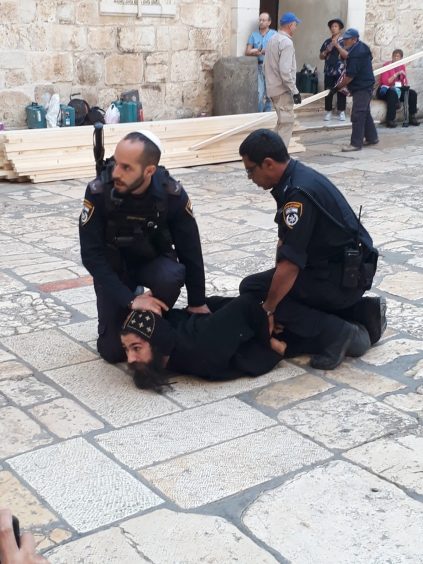The Jerusalem municipality wants to renovate a small monastery in the church, but Coptic monks say that as owners they weren’t consulted
Scenes of Israeli policemen hauling away a Coptic monk who resisted arrest outside of Jerusalem’s Church of the Holy Sepulcher on Wednesday circulated widely on social media, sparking accusations that the police treated protesting Coptic monks in a heavy-handed manner. The police, however, quickly released the monk.
The clerics assembled outside of the church—one of Christianity’s holiest sites where Jesus is believed to have been buried—to protest the planned restoration of the Deir El-Sultan monastery located on the roof of the church. Just last year, a small stone fell down from the monastery’s ceiling, a sign for inspectors that the roof is in danger of collapsing.
Commenting on the confrontation, Police spokesman Micky Rosenfeld told The Media Line that “a group of 25 representatives from the [Coptic] church blocked the entrance and didn’t allow the Israel Antiquities Authority [IAA] workers to enter. The police arrived and requested that they clear the area. One of the monks prevented the police from doing so. He was detained and short after released.”

Israeli police detain the monk who refused to move from the church’s entrance. (Coptic Orthodox Patriarchate)
The Coptic clerics have staked claim to the monastery and argue that the Jerusalem municipality, in addition to refusing them ownership of it, has also declined to allow their oversight of the repairs.
The municipality made arrangements to close down the monastery so that renovations could be completed, but ongoing disputes between the Coptic and Ethiopian sects over ownership of the monastery have held up repair work.
Fawda Shelouda, the secretary of the Coptic Orthodox Patriarchate in Jerusalem, told The Media Line that the Deir El-Sultan monastery belongs to the Coptic Church.
“This is not a religious dispute. The Ethiopians and Copts are Eastern Orthodox Christians. Instead, this is a political game between the Israeli government and Ethiopian government. The former stands firmly with the Ethiopian monks,” Shelouda said.
He explained that Israel granted the Ethiopian Orthodox Patriarchate ownership of the monastery in 1970, but then Israel’s High Court ruled the following year that it should be given back to the Coptic Church.
“We have a judgement in our favor from the Israeli High Court in 1971. Until now, the government hasn’t given us back our monastery. This is not logical. I say to Israel that if you are a democratic state, you shouldn’t hit or treat these monks in such an awful manner,” Shelouda added.
“We asked the Israeli government if we could restore it, and that we would pay the expense because this is proof we are the owners of the monastery. But the Israeli government refused these offers.”
When contacted, a representative at the Ethiopian Orthodox Patriarchate who did not want to be identified, told The Media Line that the Ethiopian monks know the monastery is in need of repair and agree on the renovations.
“But the Coptic monks also are aware of the need for repairs, but they have a problem with the government. But such disputes go back many, many years, even hundreds of years,” the representative added.
But Palestinian leaders were quick to condemn the police’s actions. “This is a continuation of Israeli interference in the status quo of the Holy Sites as well as an aggression against the peoples of Egypt and Palestine,” Saeb Erekat, a senior Palestinian official, said in a statement.
Alex Grinberg, a historian at the Middle East Center for Reporting and Analysis (MECRA), told The Media Line that “what has happened with the Coptic monks has to do with Egyptian attempts to get a foothold in Jerusalem.”
This idea was also expressed on social media, with people commenting that “the whole affair has to do with Egyptian property here.”
The monks, he explained, are saying the monastery falls under the sovereignty of Egyptian land and property and have enlisted the support of Egypt’s Embassy and Foreign Ministry in their attempt to win ownership rights of the monastery.
Armenian, Greek Orthodox, and Roman Catholic clerics have divided the Church of the Holy Sepulcher into their respective quadrants of control. When the issue of repair work surfaces, they often engage in heated disputes, even brawls, over the details of any arrangement that could alter the status quo.
Turf wars inside the church have long been acrimonious, to the point that back in the early Middle Ages when Muslims controlled the city, the keys to the church were entrusted to the Nusseibehs, a Muslim family, so as to avoid conflict between the Christian sects. To this day, a member of the family comes early to open the doors and then locks them at night when visiting hours are over.